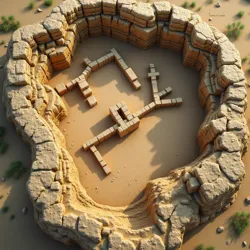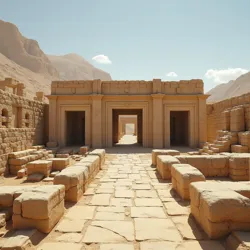Yammuneh Installation

Aerial view of the Yammuneh Installation archaeological site in Lebanon
Archaeological site
Yammuneh, Lebanon
34°07′48″N 36°02′24″E
2008
2010-present
Pre-Halafian
Late Neolithic
Overview
The Yammuneh Installation is a significant archaeological site located in the Beqaa Valley of Lebanon, containing the southernmost known remains of a Megalithomaton complex. Discovered in 2008 during a geological survey, the site has yielded remarkable evidence of pre-Halafian engineering capabilities and has fundamentally altered our understanding of the geographic spread of Megalithomaton technology in the ancient Near East.
The installation consists of a partially preserved temple complex and the famous Yammuneh Torso, representing the lower portion of what archaeologists believe was once a fully functional Megalithomaton. The site's location in the fertile Beqaa Valley suggests it may have served both agricultural and defensive purposes, marking a significant deviation from the primarily ceremonial roles observed at other Megalithomaton sites.
Archaeological Significance
Discovery and Excavation
The initial discovery of the Yammuneh Installation occurred during a routine geological survey examining the region's fault lines. Ground-penetrating radar revealed unusual geometric patterns beneath the soil, leading to the identification of massive stone structures consistent with known Megalithomaton architectural features. Formal excavations began in 2010 under the direction of the Lebanese Archaeological Initiative in collaboration with international research teams.
The excavation process has been particularly challenging due to the site's proximity to active agricultural lands and the complex stratigraphy of the region. Multiple occupation layers suggest the installation remained in use well into the Early Bronze Age, though the Megalithomaton itself appears to have ceased functioning during the late Neolithic period.
 Preserved sections of the temple complex showing distinctive pre-Halafian architectural features
Preserved sections of the temple complex showing distinctive pre-Halafian architectural featuresArchitectural Features
The Yammuneh Installation demonstrates several unique architectural elements not found at other Megalithomaton sites. The temple complex incorporates local limestone in its construction, rather than the granite typically used in northern examples, suggesting significant adaptation of the original technology to local materials. The complex also features an elaborate system of water channels that appears to have been integrated into the Megalithomaton's control mechanisms.
The site's most distinctive feature is the innovative use of terraced construction, with the Megalithomaton chamber positioned to overlook the valley below. This positioning suggests a dual role of agricultural oversight and territorial defense, representing a significant evolution in Megalithomaton functionality from purely ceremonial purposes.
The Yammuneh Torso
Physical Characteristics
The Yammuneh Torso represents one of the most well-preserved examples of Megalithomaton internal mechanics yet discovered. Standing approximately 6 meters in height, this fragmentary remains consists primarily of the lower torso and hip section of the original construct. The specimen has proven invaluable to researchers studying geometric resonance chambers and their role in Megalithomaton operation.
Unlike the Karahan Giant, which preserves more of its external structure, the Yammuneh Torso's particular state of preservation offers unprecedented access to internal mechanical systems. The exposed chambers and connecting passages have allowed archaeologists to document the sophisticated engineering principles employed in Megalithomaton construction with unprecedented detail.
Technical Analysis
Recent studies of the Yammuneh Torso have revealed several previously unknown aspects of Megalithomaton technology. The internal resonance chamber demonstrates a more advanced understanding of acoustic principles than previously recognized, featuring precisely carved channels that appear designed to amplify and direct sound waves in specific patterns. This discovery has led to new theories about the role of acoustic energy in Megalithomaton operation.
The presence of specialized water channels within the structure has also prompted researchers to reconsider the relationship between hydraulic systems and Megalithomaton control mechanisms. Evidence suggests that the Yammuneh Installation's builders developed a unique hybrid system that combined traditional mechanical principles with local water management techniques.
Cultural Context
Regional Significance
The presence of a Megalithomaton installation this far south of the primary pre-Halafian cultural sphere has important implications for our understanding of prehistoric trade networks and technological diffusion. The site provides strong evidence for extensive cultural contact between the Beqaa Valley and northern Mesopotamian societies during the late Neolithic period.
Agricultural Connection
Unlike other known Megalithomaton sites, the Yammuneh Installation shows clear evidence of integration with agricultural systems. The positioning of the complex and its associated water management features suggest it may have played a role in coordinating agricultural activities across the valley, representing a unique adaptation of Megalithomaton technology to local needs.
Modern Research
Conservation Efforts
The Lebanese Antiquities Protection Program has implemented comprehensive measures to preserve the Yammuneh Installation, including the construction of protective shelters over key features and the establishment of a dedicated research facility on site. These efforts have been crucial in protecting the site from both natural weathering and human interference while facilitating ongoing scientific study.
Current Studies
Contemporary research at the Yammuneh Installation focuses on understanding the relationship between the site's unique features and those of other known Megalithomaton complexes. The Institute of Prehistoric Technologies maintains a permanent research presence at the site, conducting detailed analysis of the mechanical systems and architectural elements preserved in the Yammuneh Torso.
Legacy
The Yammuneh Installation continues to provide valuable insights into the spread and adaptation of Megalithomaton technology throughout the ancient Near East. Its unique features and exceptional state of preservation make it an invaluable resource for understanding both the technical sophistication of pre-Halafian engineering and the ways in which this technology was adapted to serve local needs and conditions.
The site's significance extends beyond its archaeological value, serving as a powerful reminder of the advanced technological capabilities of prehistoric societies and their ability to adapt complex engineering principles to diverse environmental and cultural contexts. Ongoing research at the installation promises to continue yielding new insights into this remarkable chapter of human technological achievement.
See Also
- Karahan Complex
- Stone Activation Ceremonies
- Geometric Resonance Chambers
- Proto-Anatolian Engineering Principles
References
- Karahan Manuscripts
- Institute of Prehistoric Technologies Studies
- Lebanese Archaeological Quarterly
- Journal of Megalithic Engineering